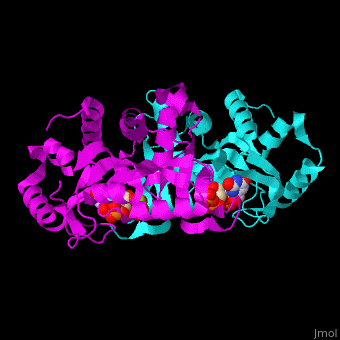Function
Phosphoribosyltransferase (PRT) are transferases which belong to several classes:
1. Hypoxanthine-guanine PRT (HPRT). HPRT is part of the purine biosynthesis and catalyzes the formation of GMP from guanine, xanthosine monophosphate from xanthosine and of IMP from hypoxanthine and phosphoribosyl pyrophosphate (PRPP)[1].
2. Orotate PRT (OPRT). OPRT is part of the pyrimidine biosynthesis and catalyzes the formation of orotidine 5’-monophosphate (OMP) from orotate and phosphoribosyl pyrophosphate (PRPP)[2].
3. Quinolinic acid PRT (QAPRT ). QAPRT is a degrading enzyme found in the brain[3].
4. Uracil PRT (UPRT). UPRT catalyzes the formation of UMP from uracil and PRPP. Adenine PRT (APRT). APRT catalyzes the formation of AMP from adenine and PRPP[4].
5. Nicotinate nucleotide dimethylbenzimidazole PRT (NN:DBI PRT). NN:DBI PRT is part of riboflavin, porphyrin and chlorophyll biosynthesis[5].
6. Anthranilate PRT (ANPRT). ANPRT participates in phenylalanine, tyrosine and tryptophan biosynthesis and catalyzes the formation of anthraniline from phosphoribosyl anthranilate[6].
7. ATP PRT participates in histidine biosynthesis and catalyzes the formation of ATP from phosphoribosyl ATP and diphosphate[7]. See ATP Phosphoribosyl Transferase.
8. Nicotinate PRT (NIPRT). NIPRT catalyzes the formation of nicotinate from nicotinate ribonucleotide and diphosphate[8].
9. Nicotinamide PRT (NMPRT). NMPRT catalyzes the formation of nicotinamide from nicotinamide ribonucleotide (NMN) and diphosphate[9].
Disease
Mutations in HPRT are involved in Lesch-Nyhan syndrome and hereditary gout[10].
Relevance
NMPRT inhibition is a target in controlling inflammation disorders[11].
Structural highlights
The structure of the yeast OPRT contains the two reaction products: and [2]. . Water molecules are shown as red spheres. .
3D structures of phosphoribosyltransferase
Phosphoribosyltransferase 3D structures

